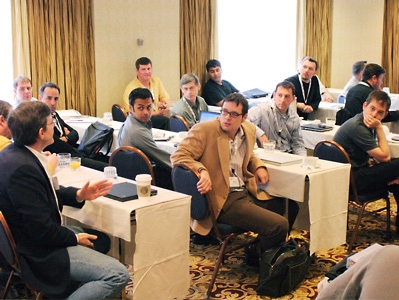 When I ran into Daniel Tosh’s marketing crew in New York City (none of us is sure which came first tosh.0 or tush.0; that chicken and egg debate will probably never be answered) and left with 400 “Tosh.5.29” wrist bands for my gigantic course in the fall, I started thinking seriously about how I want to structure the class. The biggest difference between this one and my others is that it has graduate student teaching associates (TAs!!!). When I was a TA, faculty members let us run the 50 minute discussion any way we saw fit. If we wanted to convene study sessions, we could, but the only part that really seemed to matter was consistent grading.
When I ran into Daniel Tosh’s marketing crew in New York City (none of us is sure which came first tosh.0 or tush.0; that chicken and egg debate will probably never be answered) and left with 400 “Tosh.5.29” wrist bands for my gigantic course in the fall, I started thinking seriously about how I want to structure the class. The biggest difference between this one and my others is that it has graduate student teaching associates (TAs!!!). When I was a TA, faculty members let us run the 50 minute discussion any way we saw fit. If we wanted to convene study sessions, we could, but the only part that really seemed to matter was consistent grading.
What has worked for you – either as a TA or as a faculty member:
- did the professor provide guidelines for each discussion?
- did the TA create reading quizzes?
- what’s the worst part of TAing? (beyond grading)
- what’s the best part?
If anyone can provide answers, maybe I’ll know how to best use my 8 in the fall. Here’s a guide from USC. Until then, I’ll be planning the epic barbecue we’ll have in August.




I recommend checking out David Vaught’s book _Teaching the Big Class_. I worked for Dr. Vaught as a TA/Discussion Leader, and it was, by far, the best TA-experience I had in graduate school. Here’s a link to the book: http://www.amazon.com/Teaching-Big-Class-History-Colleague/dp/0312571453/ref=sr_1_1?ie=UTF8&qid=1338580510&sr=8-1
To answer your questions:
– Yes, he did provide guidelines for discussions. This came in the form of about 10-15 questions, which he gave to all of the students, and each of the TAs. All discussions were based on readings, so the questions were meant to provoke thought and discussion about them.
– The TAs did not create reading quizzes, but we did create the essay questions, based on the readings, for our respective discussion sections. We all wrote questions based on the same readings, but were able to tailor them according to our own sections.
– The worst part of TAing is working with a poorly-organized and/or micromanaging professor
– The best part is working with a highly-organized professor who respects you as a colleague, even while also functioning as your boss!
I’ve TA’ed for eleven semesters (far too much, by all ways of looking at it).
The best part, in my estimation, has been the opportunity to teach the same lesson multiple times and thus get very good at teaching particular concepts and historical turns. The worst part–by far-has been the utter lack of freedom in planning lessons. That is, when I teach my own classes, I plan lectures, discussions, reading assignments from the beginning to be fully integrated into the evaluative part of the course (essays and exams). All the questions and reading assignments will have some bearings on at least one option for essays. THat way, no question that I raise in class is (or seems to be) irrelevant or tangential, so students feel more pressure (and sense the importance) of responding to my discussion questions.
When I TA, it’s an entirely different story. STudents know that what they will be tested on is whatever the professor decided was important (which may, or more often may not, address the matters that came up in our discussions). Exams have a large objective component (IDs, etc) and essays are largely focused on analyzing a particular set of sources, and neither of these things REQUIRES discussion section (even though attendance here really helps). This is very frustrating. THe thing is, of course, if we asked TAs to each write their own exams that corresponded with the particular curriculum of their own sections, students would complain of unfairness and TA unions would complain we are doing too much (understandably, I think). The other option as a TA is to not really bring up anything new and just reiterate what the lecturer said, but the downside of that is that it does not reward students actively listening to lecture unless the lecturer clearly raised controversial points of debate.
That brings me to my two cents of what could/should work (though I must say I’ve never seen happen): As a professor in lecture, raise thought-provoking rhetorical questions and give students a minute to think about their response! Mention the historical relevance of historical turns, and remind students how and why their interpretation matters. Yes, it may not be an actual dialogue (because all the students cannot respond to you or to one another), but it can be an opportunity to start students thinking about why coming to lecture matters, and it will provide perhaps a little more uniformity to the TA section discussions. I find that framing discussions around common historical questions works much better than common historical documents.
I don’t mean to go on here. I’ve clearly TA’ed for way too long. I’d say the ideal amount of TAing is three semesters before you get opportunities to lead your own classes (and write your own evaluation mechanisms).
Thanks Brian and Janine for these helpful suggestions. I like all of the points a lot and will definitely put into the course. (and Janine, I’ll be seeing you, at the latest, at the OAH!!!)